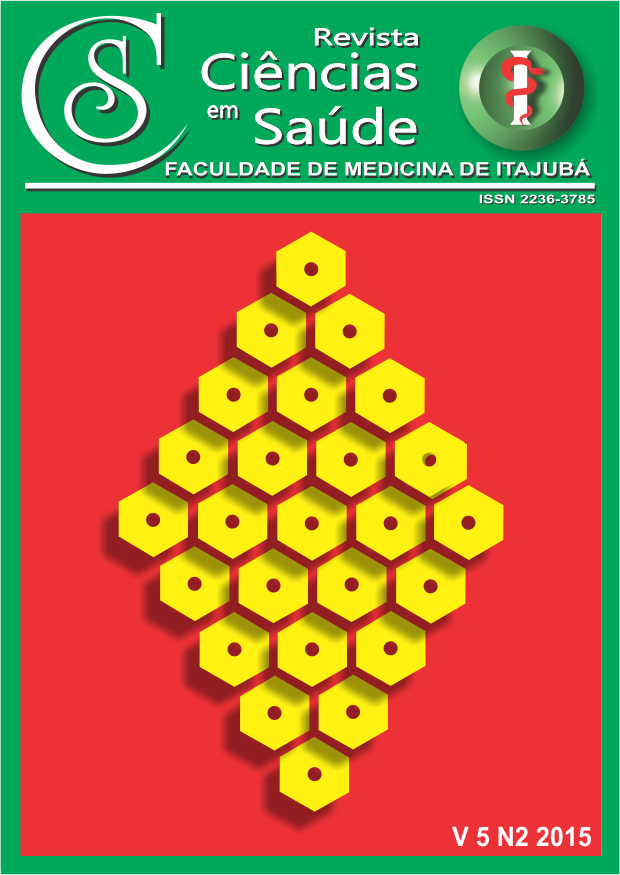Efeito do Tratamento Crônico com Extrato Aquoso de Cinnamomum zeylanicum em Ratos Induzidos à Obesidade e Hiperglicemia/Chronic Treatment Effect of Aqueous Extract of Cinnamomum zeylanicum in Mice Induced to Obesity and Hyperglycemia
Main Article Content
Abstract
RESUMO
Introdução: Uma dieta escassa em nutrientes, porém com elevado índice de lipídios somando-se a vida sedentária induz a obesidade. A partir disso, a administração do extrato aquoso de Cinnamomum zeylanicum, torna-se relevante, tendo em vista estudos sobre sua possível eficácia para o tratamento de obesidade e hiperglicemia. Objetivo: O objetivo deste estudo foi avaliar o efeito do tratamento crônico com extrato aquoso de Cinnamomum zeylanicum sobre o peso e a glicemia, em ratos induzidos à obesidade. Materiais e Métodos: Para a realização da pesquisa houve a indução à obesidade e hiperglicemia em 32 ratos machos da linhagem Wistar provenientes do Biotério da Faculdade de Medicina de Itajubá. A indução da obesidade e hiperglicemia (resistência à insulina) foi feita com a administração de Glutamato monossódico por via subcutânea na dose de 4mg/Kg, em dias alternados do 2° ao 14° dia de vida. Na 8ª semana os 32 ratos foram divididos em 4 grupos (n=8). Grupo 1 (C)- Controle: - administração de água de torneira por gavagem (n=8); Grupo 2 (M) – Tratamento Medicamentoso – administração de Metformina – concentração: 500mg/Kg/dia por (n=8); Grupo 3 (T1) – Tratamento Teste 1- administração de extrato aquoso de Cinnamomum zeylanicum (120mg/Kg) por gavegem (n=8); Grupo 4 (T2) – Tratamento Teste2- administração de extrato aquoso de Cinnamomum zeylanicum (240mg/Kg) por gavegem (n=8). Ao término do período experimental, os animais foram anestesiados com Cetamina (50mg/Kg)/ Xilazina (25mg/Kg), por via intraperitoneal e submetidos à punção intracardíaca. A retirada do sangue foi para a dosagem de glicemia de jejum. Resultados: O Tratamento Teste 1 (T1) (120mg/Kg), o Tratamento Teste 2 (T2) (240mg/Kg) e o Medicamentoso produziram diferença significantiva (p<0,05) entre os níveis de glicemia quando comparado ao Controle. Porém ao comparar os quatro grupos com relação ao Índice de Lee, não houve diferença significativa (p>0,05). Conclusão: O tratamento com extrato aquoso de Cinnamomum zeylanicum evidenciou uma diminuição da glicemia. Desta forma, são promissores os estudos com o uso da canela por período prolongado.
Palavras chave: Cinnamomum zeylanicum, Obesidade, Hiperglicemia.
ABSTRACT
Introduction: A diet with poor nutrients, but with high lipid index adding to a sedentary lifestyle leads to obesity. Due to the absence of a single drug for treating this factor, the study with intake of the aqueous extract of Cinnamomum zeylanicum, is relevant due to its possible efficacy in the studies for the treatment of obesity and hyperglycemia. Objective: The aim of this study was to evaluate the effect of chronic treatment with aqueous extract of Cinnamomum zeylanicum on weight and blood glucose in rats induced to obesity. Methods: 32 male Wistar rats were used. The induction of obesity and hyperglycemia (insulin resistance) was made with monosodium glutamate administration subcutaneously at a dose of 4 mg/kg on alternate days from the 2nd to the 14th day of life. In the 8th week, 32 rats were divided into 4 groups (n = 8). Group 1 (C) - Control: - Tap water administration by gavage (n = 8); Group 2 (D) - Drug Treatment - administration of Metformin - concentration: 500 mg/ kg/ day (n = 8); Group 3 (T1) - Treatment Test 1 - aqueous extract of Cinnamomum zeylanicum administration (120mg / kg) by gavage (n = 8); Group 4 (T2) - Treatment Test 2 - aqueous extract of Cinnamomum zeylanicum administration (240 mg / kg) by gavage (n = 8). At the end of the experimental period, the animals were anesthetized with Ketamine (50mg/kg)/ Xylazine (25 mg/kg) intraperitoneally and underwent intracardiac puncture. The withdrawal of blood was to dose fasting glucose. Results: Treatment Test 1 (T1) (120mg/kg), Treatment Test 2 (T2) (240mg/Kg) and the Drug group produced significant difference (p <0.05) between blood glucose levels compared to Control group. However when comparing the four groups regarding the Lee index, there was no significant difference (p> 0.05). Conclusion: Treatment with aqueous extract of Cinnamomum zeylanicum showed a decrease in blood glucose. Thus, the studies with the use of cinnamon for longer periods should be considered for they are promissing.
Keywords: Cinnamomum zeylanicum, Obesity; Hyperglicemia.
Article Details
Authors maintain copyright and grant the HSJ the right to first publication. From 2024, the publications wiil be licensed under Attribution 4.0 International 
 , allowing their sharing, recognizing the authorship and initial publication in this journal.
, allowing their sharing, recognizing the authorship and initial publication in this journal.
Authors are authorized to assume additional contracts separately for the non-exclusive distribution of the version of the work published in this journal (e.g., publishing in an institutional repository or as a book chapter), with acknowledgment of authorship and initial publication in this journal.
Authors are encouraged to publish and distribute their work online (e.g., in institutional repositories or on their personal page) at any point after the editorial process.
Also, the AUTHOR is informed and consents that the HSJ can incorporate his article into existing or future scientific databases and indexers, under the conditions defined by the latter at all times, which will involve, at least, the possibility that the holders of these databases can perform the following actions on the article.
